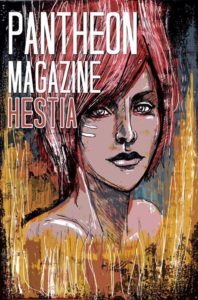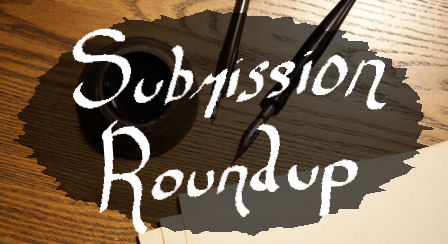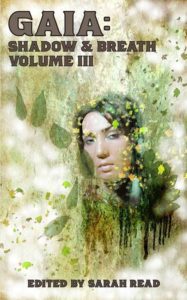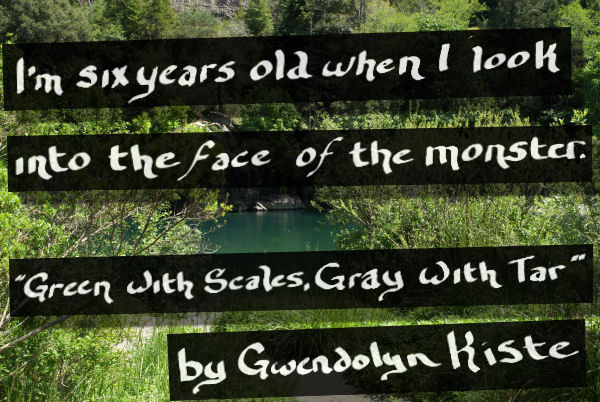Welcome back for this week’s author interview! Today, I’m thrilled to spotlight writer and editor Sarah Read. Sarah serves as the editor of the acclaimed Pantheon Magazine. As a fiction writer, her work has appeared in Black Static, Stupefying Stories, and is forthcoming from the highly anticipated Gamut.
Recently, Sarah and I discussed her inspiration as a writer as well as what lies ahead for her career.
A couple icebreakers to start: when did you first decide to become a writer, and who are some of your favorite authors?
 I decided to become a writer when I was in 6th grade, thanks to my teacher Mr. Evans. I wrote my first poem in his class and he used to let me write during recess. He’d even help me submit my work to magazines. I’m pretty sure the postage for my submissions came out of his pocket. He’d commiserate with my rejections and encourage me to keep trying. I even wrote my first ghost story in his class! He didn’t like that one as much, but he never said it–I could just tell by his eyebrows. I wish I could thank him and tell him the whole ghost story thing worked out.
I decided to become a writer when I was in 6th grade, thanks to my teacher Mr. Evans. I wrote my first poem in his class and he used to let me write during recess. He’d even help me submit my work to magazines. I’m pretty sure the postage for my submissions came out of his pocket. He’d commiserate with my rejections and encourage me to keep trying. I even wrote my first ghost story in his class! He didn’t like that one as much, but he never said it–I could just tell by his eyebrows. I wish I could thank him and tell him the whole ghost story thing worked out.
My favorite authors are Stephen Graham Jones, Helen Marshall, Neil Gaiman, China Mieville, Anne Rice, Frances Hodgson Burnett, Margaret Atwood, Ray Bradbury, Umberto Eco, Paul Tremblay, Peter S. Beagle, Caitlin R. Kiernan, and lots more. The list grows every year.
You serve as the editor at Pantheon Magazine. How did you become involved with editing, and how has your work as an editor shaped your writing? Also, what advice can you offer writers who are interested in submitting to the magazine?
I’ve been interested in editing ever since my high school lit mag and newspaper days. After college, I spent six years as a magazine editor for a large publisher. Matt Garcia, the publisher of Pantheon, asked me to read slush for him after he’d published a few of my stories–I enjoyed that way more than I think you’re supposed to. People say it’s torture, but I love it. (I actually still read a lot of the slush. Shhh, I can’t help it.) After a while, he promoted me to fiction editor, and then he decided to step more into the background and let me have control over all the red buttons. We still work together quite closely on the magazine, and he oversees the website and production side of things.
Editing helps me analyze a story without getting lost in it–but I still want to get lost in it. It’s much harder with my own work, of course, but I can switch off the writerly part of my brain and view things through an analytical lens. Getting the edit-y part of my brain to shut up is another matter. I have a lot of trunk stories because of it.
As for advice, definitely pay attention to the issue theme. I hate it when I read a lovely story that has nothing to do with that issue and I have to reject it even though I enjoyed it. We ask for an explanation of how the story relates to the theme–even if the tie is loose, if we love the story and there’s a logical argument, we’ll probably take it. Also, we’re on a budget. There’s a set word count limit for each issue, so if your story is over 7k words, it’s probably going to have to be AMAZING to get in. We’re happy to read longer stories (and we’ve taken quite a few), but nine out of ten stories I read that are over 7k words are 4-5k stories with too much fluff.
The theme of Pantheon is Greek myth-themed fiction. When did you first become interested in mythology, and do you have a favorite god or goddess?
I’ve always been obsessed with myth–not just Greek myths, but all kinds. I’d like to someday take the magazine’s themes to other cultures, too. The Greek myths are a blast, and there’s a deity for nearly everything, but it feels too narrow. There are a lot of fun themes out there to play with. I love the idea that humans can explore their curiosity through creative storytelling. Myths hold a special kind of truth that doesn’t necessarily have anything to do with reality. I like contemporary stories that have that same touch of truth about them–that feel like they’re tied in to something much bigger than what’s on the page.
I’ve never been religious at all, but I’ll refrain from picking a favorite. That NEVER ends well.
You have previously discussed your love of journals and fountain pens. How do you feel the act of handwriting your fiction affects your work as an author? Also, do you remember your very first writing journal and pen?
 Mmmm yes, I LOVE pens and ink and paper. I’m honestly not sure if I love them because I love writing, or if I love hand writing because I get to use my pens. I may never know, but it doesn’t matter. My relationship with technology has never been very good, so the reliability of analog tools is also a bit of a necessity. I have my laptop and Google Drive and flash drives and external hard drives…but it’s good to have that hard copy there on the shelf. My first drafts are slower, yes, but I edit as I type the draft in, so by the time I have a copy to send to beta readers, it’s often the third draft. Plus, I can have a pen and notebook in my pocket always and everywhere. I get a lot of my writing done in stolen moments between things.
Mmmm yes, I LOVE pens and ink and paper. I’m honestly not sure if I love them because I love writing, or if I love hand writing because I get to use my pens. I may never know, but it doesn’t matter. My relationship with technology has never been very good, so the reliability of analog tools is also a bit of a necessity. I have my laptop and Google Drive and flash drives and external hard drives…but it’s good to have that hard copy there on the shelf. My first drafts are slower, yes, but I edit as I type the draft in, so by the time I have a copy to send to beta readers, it’s often the third draft. Plus, I can have a pen and notebook in my pocket always and everywhere. I get a lot of my writing done in stolen moments between things.
I do actually remember my first journal. It was white with wee blue flowers on it. I think I was in first or second grade–it had a padlock that I had to break myself because I lost the key. I mostly wrote about how irritating my brother was. It still exists, somewhere.
Your incredibly creepy horror story, “Magnifying Glass,” appeared last year in the esteemed Black Static. What was the inspiration behind this piece?
That story was written from a prompt given to me in one of my writing group’s WAR battles. The prompt was a character finding (in a very unlikely place) an old envelope that’s addressed to them. The hand prints were inspired by an actual hand print on a window in my old house. I could never wipe it off. It was a deliciously frightening five seconds until I remembered it was a double-pane window–the print was between the layers. And it made me think of how my grandmother never wiped our hand prints off her storm door after we visited, because she liked to see that piece of us still there even when we were far away. Sometimes we’d come at Christmas and see our sticky fourth-of-July hand prints on the glass and hold our hands up to them to see how much we’d grown. And then of course I wondered when the hand print got between my windows–and how much has that person grown? It’s a very old house–what if the person is dead–what if they still come back to their hand print inside the glass? Wonder why they haven’t grown? Probably too many of my stories are born out of my mind wandering while I do housework.
What upcoming projects are you working on?
I’m reaching the end of a manuscript revision for a revise and resubmit request from an agent. I haven’t been writing much short fiction because I’ve been buried in that. I’m hoping to resubmit in the next month or so. Scary! I’ve got a few short stories in the works, though, for some fun projects I’ve been invited to. Matt Garcia and I are also collaborating on a novella. It’s just a skeletal armature so far, but we’ll break out the papier-mache soon.
Where would you like to see your writing career in five years?
Gosh, three years ago I’d be excited just to think I’d have anything published at all. I’d like for my novel to see the light of day before the next five years is up. And I’d like to crack one of my white whale markets (Shimmer or Nightmare especially).
I’ve really enjoyed working freelance since my youngest was born. I’d like to move more in the direction of editing people’s novels and less toward writing marketing copy for big tech companies.
Big thanks to Sarah Read for being part of this week’s author interview series! Find her online at Twitter, Instagram, and her author site.
Happy reading!
 Enchanted Conversation Magazine
Enchanted Conversation Magazine



